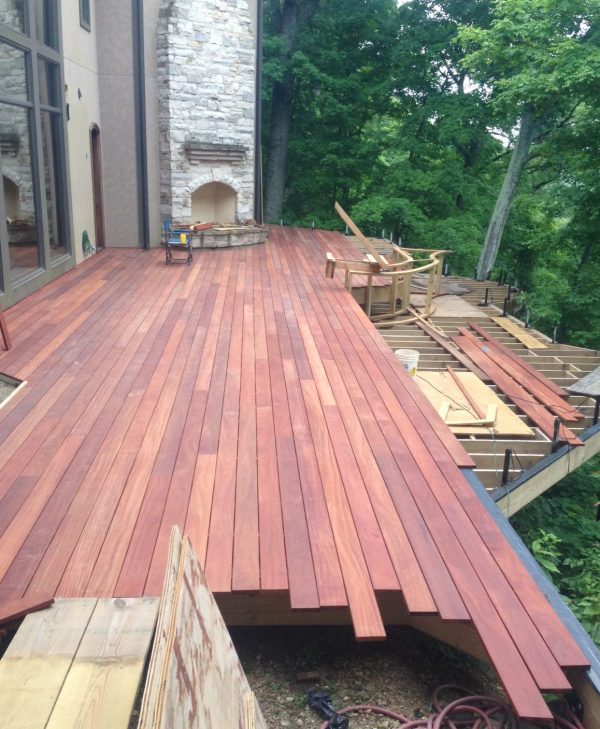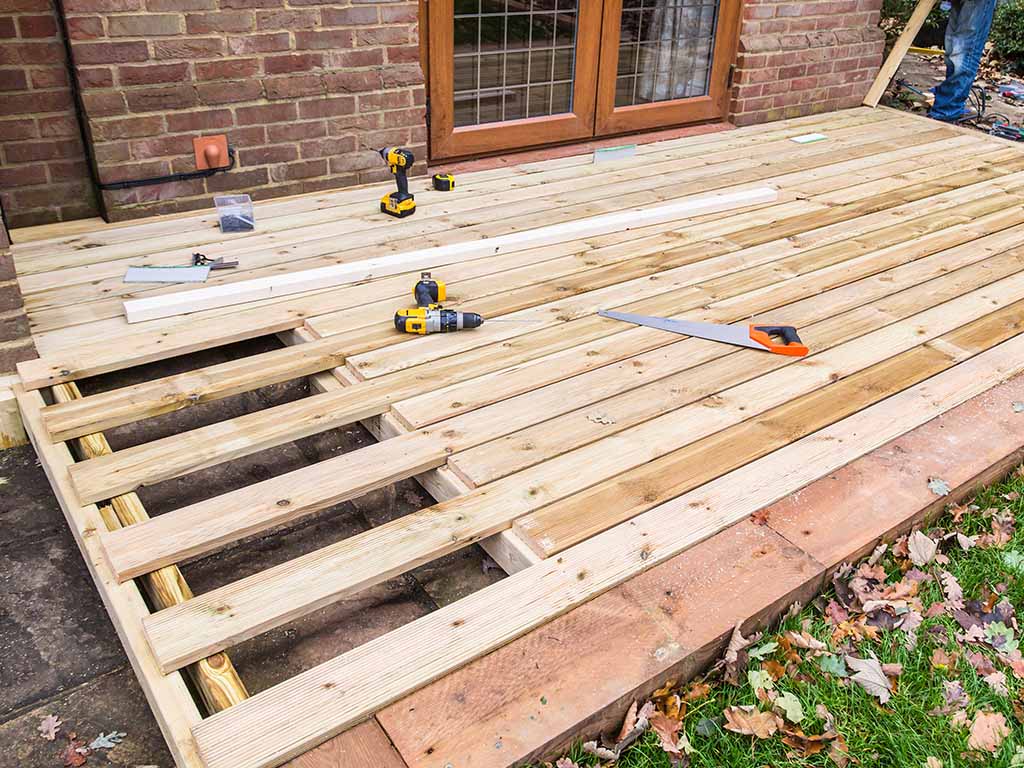Just how to Choose the Right Materials for Your Deck Installation Project
Picking the suitable products for your deck installation task can seem challenging. The key is to balance your spending plan, layout preferences, and way of living needs to create a deck that will certainly enhance your exterior area for years to come.
Understanding the Various Kinds Of Deck Materials
When embarking on a deck installment project, the option of materials ends up being a critical decision. Compound materials, on the other hand, are a mix of wood and plastic, giving durability and resistance to weather elements. By comprehending these distinctions, house owners can make a more educated decision on the most ideal deck material for their particular requirements.
Evaluating the Resilience and Maintenance Needs of Deck Materials
Analyzing the resilience and upkeep needs of deck materials is a critical action in deck setup. Toughness entails the material's capacity to withstand severe climate condition, deterioration, and its durability. Cedar and redwood are normally immune to rot and insects, making them durable options. On the other hand, pressure-treated wood, while resilient, may need even more upkeep due to its susceptibility to cracking and deforming.
Recognizing maintenance needs is similarly essential. Some materials call for routine sealing or discoloring to preserve their appearance and stand up to dampness damage, while others, like composite decking, require much less upkeep. By assessing these variables, one can pick one of the most suitable decking material, guaranteeing a balance between durability, upkeep needs, and visual appeal.
Expense Analysis: Contrasting Timber and Composite Decking
Although cost might initially look like a secondary worry, it is a substantial aspect when comparing wood and composite decking. Timber, typically a cheaper option, has a reduced ahead of time price. Nonetheless, with time, upkeep expenses can accumulate, potentially making wood more costly in the future. These maintenance expenses may consist of discoloration, sealing, or changing harmed boards. On the various other hand, composite decking, while costlier originally, requires less upkeep, potentially reducing long-term expenses. It's crucial to remember that composite outdoor decking isn't resistant to wear and tear, and substitute expenses can be high. Possible deck proprietors must consider their budget and readiness to maintain their decks when deciding between wood and composite outdoor decking.
Aesthetic Appeals and Design Adaptability of Decking Products
While expense is a crucial factor to consider, the aesthetic appeal and design flexibility of outdoor decking materials also play a significant role in the decision-making procedure. Various products provide differing degrees of aesthetic appeal. As an example, natural wood outdoor decking supplies a traditional, timeless appearance, while composite products use a vast array of colors and textures to fit diverse tastes and styles. Style flexibility refers to the capability to form and adjust the outdoor decking material to meet particular layout needs. Wood, for example, offers high layout adaptability due to its ease of reducing and shaping. Composite materials, while much less versatile in style, are still versatile sufficient for a lot of deck layouts. These factors, consequently, are crucial components in the option of decking material.
Ecological Impact of Decking Products
When selecting outdoor decking products, one have to consider not just appearances and sturdiness, but likewise the environmental effect. It is essential to assess the sustainability of materials and explore recycled decking choices. Moreover, understanding the potential influence on neighborhood communities will certainly ensure a much more ecologically responsible choice.
Examining Product Sustainability
In the realm of deck building and construction, examining product sustainability is an essential step. This involves assessing the ecological effect of each prospective material, taking into consideration aspects such as the energy needed for its manufacturing, its carbon footprint, and its end-of-life disposal or reusing options. For instance, wood is a renewable energy, however unsustainable logging methods can cause logging. Conversely, composite outdoor decking materials often integrate wood and plastic, lowering the need for brand-new timber yet enhancing reliance on nonrenewable fuel sources. Light weight aluminum and various other metals might be extra durable and recyclable, but their removal and processing can be energy-intensive. Hence, the selection of decking products ought to balance performance, aesthetics, cost, and sustainability to guarantee a responsible and long-lasting installation.
Recycled Outdoor Decking Alternatives

Compound outdoor decking is specifically prominent due to its toughness and simplicity of maintenance. It's resistant to rot, insects, and fading, making it a long-lasting choice. Recycled plastic decking, on the various other hand, is extremely resilient and requires minimal maintenance. While these materials might bring a higher preliminary cost, their durability and lowered environmental influence make them a wise financial investment for the eco-conscious homeowner.

Influence On Local Communities
While the benefits of using recycled products for outdoor decking can not be overstated, it's equally important to take into consideration the more comprehensive ecological effects of these options. The extraction, processing, and transport of materials can greatly influence regional environments. Deforestation for wood outdoor decking adds to habitat loss and climate modification. Even the manufacturing of composite products can release dangerous emissions. Conversely, making use of recycled or sustainably sourced materials can aid mitigate these effects. Moreover, taking into consideration the life-span of materials can reduce ecological effect; longer-lasting options call for much less constant substitute, hence preserving resources. Appropriate disposal of old decking is essential to reducing land fill waste. Essentially, an eco-conscious deck job demands cautious product choice, sustainable sourcing, and responsible disposal.
Making Your Decision: Tips for Choosing the very best Deck Materials
As the post changes right into the subtopic of "Making Your Decision: Tips for Choosing the most effective Deck Materials", it is essential to understand the variety of deck products readily available. Striking an equilibrium between toughness and appearance is essential in this choice process. The adhering to conversation will certainly assist visitors in making an informed selection based upon these essential considerations.
Understanding Various Deck Products
The job of selecting the right products for your deck installation can seem discouraging due to the substantial range of options available. Vinyl or PVC decks are even extra sturdy and require much less maintenance than composite materials, but they can look much less natural. Light weight aluminum decks are strong, lightweight, and resistant to rot, however they are additionally the most costly option.
Durability vs. Aesthetics Equilibrium
Balancing resilience with visual appeals can be a challenge when picking deck materials - deck installation austin tx. High-traffic locations might necessitate sturdy materials like composite outdoor decking, which endures wear and tear yet might do not have the natural elegance of timber. Property owners require to strike look these up an equilibrium, considering both the deck's functional needs and their aesthetic preferences.
Conclusion
In verdict, selecting the appropriate products for your deck installation project needs cautious consideration of aspects such as longevity, upkeep, price, looks, and ecological impact. Whether you select standard timber best site or composite materials, your option must line up with your budget plan, style preferences, and way of life. Inevitably, the very best outdoor decking material is one that improves your outside area and gives pleasure for many years to come.